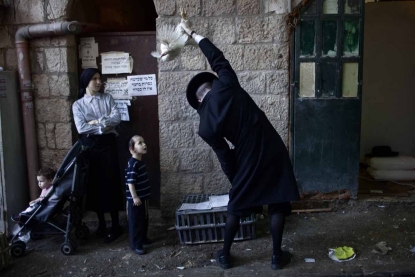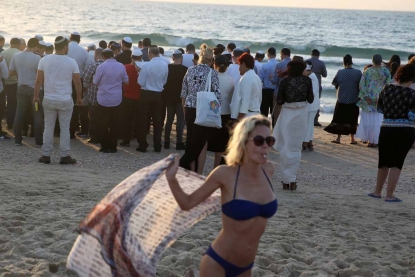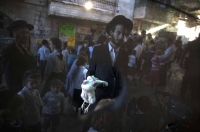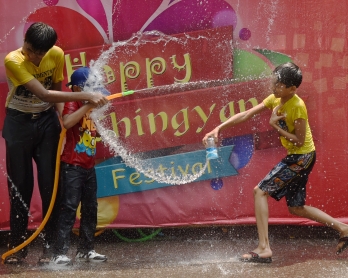Of chickens, fishes and sins
Jerusalem -- This time of year is always busy for us news photographers in Israel. Between Rosh Hashana, the Jewish New Year, and Yom Kippur, the holiest day in the Jewish calendar, there are lots of rituals among the ultra-religious community that make for really colorful photos.
One of the most colorful is something called the Kaparot, a ceremony that involves chickens and that takes place in the few days preceding Yom Kippur, otherwise known as the Day of Atonement. According to tradition, swinging a live chicken over your head three times will pass your sins to the bird. Might seem bizarre to some, but that’s the norm among the ultra-religious here and it makes for some really unusual photos.
 October, 2011. (AFP / Menahem Kahana)
October, 2011. (AFP / Menahem Kahana)My favorite place to shoot this is Mea Shearim, a neighborhood of ultra-religious Jews in West Jerusalem. I have been coming here for years and I really like the feel of the place. It’s a very tight-knit community, where people dress and keep the same traditions as they did hundreds of years ago.
Everyone here knows everyone else. The family is very important, having lots of children is encouraged and there are hundreds of them everywhere. It’s not uncommon to see six- and eight-year-olds walking to school alone. Perhaps because you have lots of people crammed into a not very large space, it’s very much alive -- everyone is shopping, talking.
 September, 2007. (AFP / Menahem Kahana)
September, 2007. (AFP / Menahem Kahana)The Kaparot is an institution here. Special slaughterhouses are set up in the days before Yom Kippur, with lines of families snaking outside. They purchase a chicken, perform the ceremony and then give the chicken to the slaughterhouse, where a rabbi will kill it in the “kosher” way and then usually the chicken is given away as charity.
Like everything in strictly observant Judaism, there are lots and lots of rules, which different people follow to various degrees. Some people make sure that the chicken takes four steps before they swing it, to make sure that it is indeed alive. Some people will swing one chickent above the heads of their entire family. Some will swing two chickens over a pregnant woman.
 (AFP / Menahem Kahana)
(AFP / Menahem Kahana)People in Mea Shearim don’t always have the nicest reputation with outsiders. They fiercely cling to traditions dating back hundreds of years, which can often be at odds with the modern world. For example, they don’t drive during Shabbat, the Jewish day of rest that falls on Saturdays, and cars driving through the neighborhood during that time risk getting a stone thrown at it.
But I feel at home here. I have been coming here for years, so I know people, I have friends here. I like the feel of the place. They look like they did hundreds of years before, they behave like they did hundreds of years before, but at the same time, many have smartphones. And as far as photography, I rarely have had trouble with the locals. They don’t mind being photographed and they just go about their business.
 (AFP / Menahem Kahana)
(AFP / Menahem Kahana)But I do run into trouble with outsiders. This year, one guy, who was not from the neighborhood, began demanding why I was taking pictures and what I was going to do with them. The Kaparot is not without controversy, especially with animal rights activists who oppose it. I guess this guy thought that I was going to give the pictures to such activists and took it upon himself to ‘defend’ the Haredis. And, funnily enough, another group of people who give me trouble are secular people who come here to perform the ritual. Maybe they don’t want their friends finding out that they are practicing such a tradition..
 (AFP / Menahem Kahana)
(AFP / Menahem Kahana) (AFP / Menahem Kahana)
(AFP / Menahem Kahana)
Another colorful ritual during this time of the year is Tashlich, a prayer during which you symbolically cast your sins to the fish. So you have to perform it in front of a body of water with fish in it.
Some people go to the sea, which gives for some nice contrast pictures -- you have religious people, dressed religiously, praying, while secular people are sunbathing in bikinis nearby.
 Ashdod, October, 2016. (AFP / Menahem Kahana)
Ashdod, October, 2016. (AFP / Menahem Kahana)Some people go to a river or spring. And some will get a plastic pool, put a few fish in it and perform the prayer in front of the synagogue.
 Bnei Brak, near Tel Aviv, September, 2010. (AFP / Menahem Kahana)
Bnei Brak, near Tel Aviv, September, 2010. (AFP / Menahem Kahana)And then there is Yom Kippur itself, which is always nice to photograph. Israel all but shuts down for the holiday -- the airport is closed, very few people drive, most shops are closed. It’s the holiest day in Judaism and even many secular Jews, who don’t celebrate other holidays, will mark this one.
Parts of Israel resemble sets of sci-fi thrillers -- because streets are devoid of cars, children play in the middle of the roads, people stroll in the middle of the highways, and everyone it seems gets on their bike. Which always makes for nice pictures as well.
 Tel Aviv, October, 2014.
(Getty Images/AFP / Ilia Yefimovich)
Tel Aviv, October, 2014.
(Getty Images/AFP / Ilia Yefimovich)We shoot these pictures every year, but every year you look for a different angle. You can always find something different and original. But not me this year. This year, I’m taking the day off.
This blog was written with Yana Dlugy in Paris.









